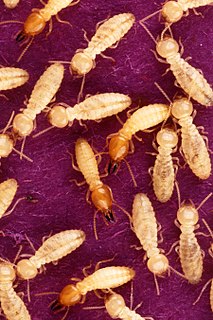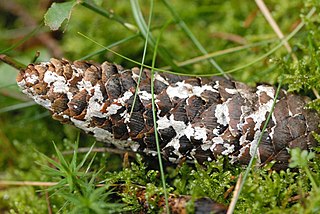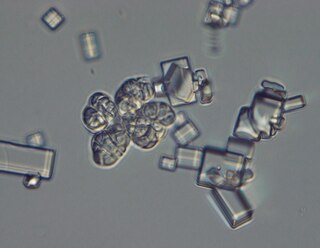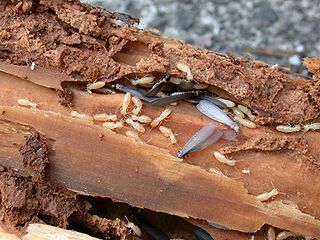
Termites are eusocial insects that are classified at the taxonomic rank of infraorder Isoptera, or as epifamily Termitoidae within the order Blattodea. Termites were once classified in a separate order from cockroaches, but recent phylogenetic studies indicate that they are related to cockroaches, as they are the sister group to wood eating cockroaches of the genus Cryptocercus. Previous estimates suggested the divergence took place during the Jurassic or Triassic. More recent estimates suggest they have an origin during the Late Jurassic, with the first fossil records in the Early Cretaceous. About 3,106 species are currently described, with a few hundred more left to be described. Although these insects are often called "white ants", they are not ants, and are not closely related to ants.

The Polyporales are an order of about 1800 species of fungi in the division Basidiomycota. The order includes some polypores as well as many corticioid fungi and a few agarics. Many species within the order are saprotrophic, most of them wood-rotters. Some genera, such as Ganoderma and Fomes, contain species that attack living tissues and then continue to degrade the wood of their dead hosts. Those of economic importance include several important pathogens of forest and amenity trees and a few species that cause damage by rotting structural timber. Some of the Polyporales are commercially cultivated and marketed for use as food items or in traditional Chinese medicine.

Cordyceps is a genus of ascomycete fungi that includes about 600 species. Most Cordyceps species are endoparasitoids, parasitic mainly on insects and other arthropods ; a few are parasitic on other fungi. The generic name Cordyceps is derived from the Greek word κορδύλη kordýlē, meaning "club", and the Greek word κεφαλή cephali, meaning "head".

Malassezia is a genus of fungi. Malassezia is naturally found on the skin surfaces of many animals, including humans. In occasional opportunistic infections, some species can cause hypopigmentation or hyperpigmentation on the trunk and other locations in humans. Allergy tests for this fungus are available.

Aspergillus is a genus consisting of a few hundred mould species found in various climates worldwide.

Beauveria bassiana is a fungus that grows naturally in soils throughout the world and acts as a parasite on various arthropod species, causing white muscardine disease; it thus belongs to the entomopathogenic fungi. It is being used as a biological insecticide to control a number of pests such as termites, thrips, whiteflies, aphids and different beetles. Its use in the control of bedbugs and malaria-transmitting mosquitos is under investigation.

Metarhizium anisopliae, formerly known as Entomophthora anisopliae (basionym), is a fungus that grows naturally in soils throughout the world and causes disease in various insects by acting as a parasitoid. Ilya I. Mechnikov named it after the insect species from which it was originally isolated – the beetle Anisoplia austriaca. It is a mitosporic fungus with asexual reproduction, which was formerly classified in the form class Hyphomycetes of the phylum Deuteromycota. According to Paul Stamets, it could be the answer to prevent colony collapse disorder and catastrophic famine.

Pneumocystis jirovecii is a yeast-like fungus of the genus Pneumocystis. The causative organism of Pneumocystis pneumonia, it is an important human pathogen, particularly among immunocompromised hosts. Prior to its discovery as a human-specific pathogen, P. jirovecii was known as P. carinii.

Schizophyllum commune is a species of fungus in the genus Schizophyllum. The mushroom resembles undulating waves of tightly packed corals or loose Chinese fan. "Gillies" or "split gills" vary from creamy yellow to pale white in colour. The cap is small, 1–4 cm wide with a dense yet spongey body texture. It is known as the split-gill mushroom because of the unique longitudinally divided nature of the "gills" on the underside of the cap. It is the only known fungus capable of retracting by movement. This mushroom is found throughout the world.

Beauveria is a genus of asexually-reproducing fungi allied with the ascomycete family Cordycipitaceae. Its several species are typically insect pathogens. The sexual states (teleomorphs) of Beauveria species, where known, are species of Cordyceps.
Geomyces is a genus of filamentous fungi in the family Myxotrichaceae. Members of the genus are widespread in distribution, especially in northern temperate regions. Known to be psychrotolerant and associated with Arctic permafrost soils, they are equally prevalent in the air of domestic dwellings, and children's sandpits. Species of Geomyces have previously been placed in the genus Chrysosporium.

Atheliaceae is a family of corticioid fungi placed under the monotypic order Atheliales. Both the order and the family were described by Walter Jülich in 1981. According to a 2008 estimate, the family contains 20 genera and approximately 100 species. However, many genera formerly considered to belong in the Atheliaceae have since been moved to other families, including Amylocorticiaceae, Albatrellaceae, and Hygrophoraceae. Despite being a relatively small group with inconspicuous forms, Atheliaceae members show great diversity in life strategies and are widespread in distribution. Additionally, being a group strictly composed of corticioid fungi, they may also provide insights on the evolution of fruiting body forms in basidiomycetes.

Chorioactis is a genus of fungi that contains the single species Chorioactis geaster. The mushroom is commonly known as the devil's cigar or the Texas star in the United States, while in Japan it is called kirinomitake (キリノミタケ). This extremely rare mushroom is notable for its unusual appearance and disjunct distribution; it is found only in select locales in Texas and Japan. The fruit body, which grows on the stumps or dead roots of cedar elms or dead oaks, somewhat resembles a dark brown or black cigar before it splits open radially into a starlike arrangement of four to seven leathery rays. The interior surface of the fruit body bears the spore-bearing tissue known as the hymenium, and is colored white to brown, depending on its age. The fruit body opening can be accompanied by a distinct hissing sound and the release of a smoky cloud of spores.

Rhizoctonia is a genus of anamorphic fungi in the order Cantharellales. Species do not produce spores, but are composed of hyphae and sclerotia and are asexual states of fungi in the genus Thanatephorus. Rhizoctonia species are saprotrophic, but are also facultative plant pathogens, causing commercially important crop diseases. They are also endomycorrhizal associates of orchids. The genus name was formerly used to accommodate many superficially similar, but unrelated fungi.

Wallemia ichthyophaga is one of the three species of fungi in the genus Wallemia, which in turn is the only genus of the class Wallemiomycetes. The phylogenetic origin of the lineage was placed to various parts of Basidiomycota, but according to the analysis of larger datasets it is a (495-million-years-old) sister group of Agaricomycotina. Although initially believed to be asexual, population genomics found evidence of recombination between strains and a mating type locus was identified in all sequenced genomes of the species.
Aspergillus marvanovae is a species of fungus in the genus Aspergillus which has been isolated from water with high boracic acid anions from the Dukovany nuclear power station in the Czech Republic. It is from the Fumigati section. Several fungi from this section produce heat-resistant ascospores, and the isolates from this section are frequently obtained from locations where natural fires have previously occurred. The species was first described in 2014. Aspergillus marvanovae produces apolar indoloterpenes.
Aspergillus huiyaniae is a species of fungus in the genus Aspergillus. It is from the Fumigati section. Several fungi from this section produce heat-resistant ascospores, and the isolates from this section are frequently obtained from locations where natural fires have previously occurred. The species was first described in 2014. It has been isolated from desert soil in Xinjiang, China.

Reticulitermes speratus, the Japanese termite, is a species of subterranean termite found in Japan, North Korea, and South Korea. It eats decayed wood. It is adapted to withstand the cold temperatures of the temperate regions it inhabits.

Fungal DNA barcoding is the process of identifying species of the biological kingdom Fungi through the amplification and sequencing of specific DNA sequences and their comparison with sequences deposited in a DNA barcode database such as the ISHAM reference database, or the Barcode of Life Data System (BOLD). In this attempt, DNA barcoding relies on universal genes that are ideally present in all fungi with the same degree of sequence variation. The interspecific variation, i.e., the variation between species, in the chosen DNA barcode gene should exceed the intraspecific (within-species) variation.

The Herpomycetales is an order of fungi within the class Laboulbeniomycetes. The order includes a single dioecious genus, Herpomyces, with 27 accepted species of obligate ectoparasites that are associated exclusively with cockroaches. Like the Laboulbeniales order, they produce cellular thalli. However, the thalli of Herpomyces are developmentally and morphologically unique.

















